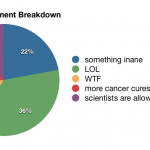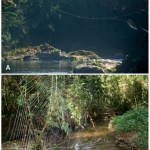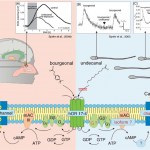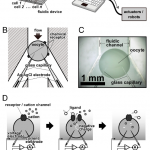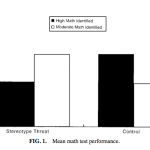Research
Yesterday I mentioned Symbiotic Households, an art project imagining genetically engineered mosquitoes that provide mood stabilizing compounds to a population plagued by worries caused by climate change. Today on twitter I saw a link to a US patent application filed by Microsoft about engineering parasites to monitor and maintain human health. The possible engineered parasites covered in the application include:
mosquitoes, fleas, ticks, bed bugs (Cimicidae Cimex lectularius), midges (such as Ceratopogonidae), other blood sucking arthropods, annelids or leeches, nematodes such as Ascaris…
Lena works in a turkey processing plant in Iowa. She's up by 5:30 am, eats sensibly, is not overweight and has never smoked tobacco. Lena should be the picture of health, but her job makes her feel much older than her 32 years. Over her 10-hour work shift, she makes about 20,000 cuts on the turkey carcasses that move in front of her at a rate of 30 per minute. Lena has chronic pain in her wrist, arms and shoulders. Her physical pain is exacerbated by other work-related stress. Lena earns several dollars per hour over minimum wage, but she has to work another job part-time to help pay…
Evolution connects all living things on earth, from the arsenic tolerant bacteria in the news this week to the human scientists and bloggers chatting about it. Eyes are intricately complex structures made up of many many cells, but even single-celled microbes can sense and respond to light through the function of proteins that share evolutionary similarity with the light receptors of the human retina. Incredibly, genetic engineering is showing us just how similar these proteins can be--transferring the genes that code for these processes leads to functional proteins, even when huge…
Nick pointed me to a fabulous podcast series by CBC radio called "How To Think About Science." Each episode is a long and fascinating interview with a prominent scholar of science--scientists, philosophers, sociologists, anthropologists, and historians who explore how science is done, how scientists work, and how scientific ideas and facts are communicated. Check it out!
It's not just Scott Kern who thinks that science is only about tedious benchwork and that grad students should be boring robots moving small volumes of liquid around 20 hours a day for the greater good. An unscientific analysis of the 169 comments and numerous comment thumbs ups of Hydrocalypse Industries' most popular video shows that a significant percentage of the commenters who aren't saying something completely inane, off topic, or conspiracy-theory laden are criticizing us for not working hard enough.
I hopefully don't need to go into detail about how many hours we are all actually…
There was some big news yesterday in transgenic silk from Notre Dame and the University of Wyoming, where scientists have genetically engineered silkworms to produce silk that is a mixture of spider silk and the regular silkworm stuff. Silkworms produce the strong and versatile silk that is used to make clothes, but spiders produce silk that can be much stronger and much more elastic. Spiders, however, don't like to be grown in huge factories and don't make easily harvested cocoons like silkworms, so gathering even small amounts is very difficult (here's a fun how-to for collecting spider…
Peter Janiszewski at Obesity Panacea has posted a fascinating series on the issue of people who are obese but metabolically healthy. We worry about rising rates of obesity because obesity increases the risk for health problems like diabetes and cardiovascular disease -- but what if that's not universally true? And if it turns out that some obese people aren't at an increased risk of chronic diseases, should they still be urged to lose weight?
The first post in the series introduces the definitions of "obese" and "metabolically healthy":
To date, countless epidemiological studies have shown…
So I was browsing the internet for info on G-protein coupled receptors and ended up finding some interesting facts about sperm. It turns out sperm don't just swim blindly, hoping to randomly bump into eggs. Instead, like bacteria, sperm can sense their chemical environment and adjust their swimming accordingly. Sperm have a sense of smell.
The (g-protein coupled) olfactory receptors in our noses that activate our sense of smell were discovered in 1991, an amazing discovery that earned the 2004 Nobel prize for physiology or medicine. The receptors sit on the surface of the cells up high in our…
Noise obscures meaningful information. Noise is what ruins your carefully designed synthetic biology gene circuit. But noise is part of life and life, it turns out, needs noise. There's a terrific review article in this week's Nature discussing recent theoretical and experimental work on biological noise showing functional roles for molecular, genetic, and evolutionary noise.
From the abstract:
The genetic circuits that regulate cellular functions are subject to stochastic fluctuations, or 'noise', in the levels of their components. Noise, far from just a nuisance, has begun to be…
A lot of synthetic biology is about getting biology to be more like electrical engineering, designing genetic "logic gates" to create a living circuit board. Beyond analogies, however, cells have many fascinating electrical properties--proteins that transfer electrons like wires, membranes that separate ions and create an electrical charge that drives the metabolism of the cell, channels through these membranes that open and close to activate an electro-biological response. Electrons are electrons whether they are in proteins or copper wires, and many scientists have designed ways to connect…
Check out Carnal Carnival #1: Essentials of Elimination, hosted by Bora at A Blog Around the Clock. It's a fascinating collection of blog posts all about poop. (The post I put up yesterday on sanitation is among them.) Many of the posts are about the interesting things scientists can learn by studying excrement - human or animal, fresh or fossilized.
A couple of the posts deal with a topic that seems to be attracting more and more attention: gut flora, or the microbiome. Basically, our digestive systems are colonized by a range of microbes, some of which assist us with digestion and vitamin…
Senators John McCain and Tom Coburn have released a report on "100 Stimulus Projects that Give Taxpayers the Blues." Their introduction rails against "torrential, misdirected government spending," and short descriptions of the 100 projects singled out for ridicule are evidently supposed to disgust readers. What disgusted me, though, was an apparent lack of respect for scientific research.
Around one-fourth of the 100 projects involved scientific research, and I have to wonder whether their criteria for inclusion was a word that might make a sixth-grader giggle. Monkeys! Ants! Hot flashes!…
tags: Close Encounter with a Whale Shark in the Gulf of Mexico, marine biology, field research, research, technology, whale shark, Rhincodon typus, satellite tags, Gulf of Mexico, BP, Gulf Coast Research Laboratory, University of Southern Mississippi, streaming video
Whale Shark, Rhincodon typus, feeding in the Gulf of Mexico.
Image: Gulf Coast Research Laboratory Whale Shark Research.
Despite being the largest fish species in the world, measuring over 40 feet in length and 35 tons in weight, whale sharks are quite mysterious. We know they are plankton filter feeders, and we recently…
Regular readers know that that Peter and I do a semi-regular podcast on obesity-related issues. This week, I have a discussion with psychology researcher (and fellow ScienceBlogger) Jason Goldman (UPDATE: Jason's thoughts on the podcast here). For the uninitiated, self-report data refers to information that people provide themselves - questionnaires and interviews are very common examples. This is in contrast to direct measurement, which is exactly what it sounds like - researchers measuring your height and weight themselves, etc. The podcast was inspired by a recent…
iGEM officially starts for the Harvard team tomorrow for some good old-fashioned fun with BioBricks, arabidopsis, protein-based sweeteners, and shRNA! Our goal is to make a system for genetically engineering plants safely and easily with some hopefully fun and useful applications in the short term. iGEM (the International Genetically Engineered Machines competition) is about fun and open science, so we hope you enjoy following along with our adventure on our wiki, blog, twitter, or even become a fan on facebook. As a proud teaching fellow I'll be posting updates here periodically all summer,…
In the recent articles, blog posts, and comment threads about possible biological reasons for the continued gender disparity in tenured math and science faculty positions, the discussion seems to be divided between two groups: those who emphasize the social and cultural aspects involved in gender and intelligence, and those who emphasize the scientific evidence of standardized test performance. The science team rails against "political correctness," claiming that by questioning the merits and motives of scientific hypotheses of differences in innate intelligence between different groups of…
Silk is an amazing biomaterial, cultivated and prized for more than 5,000 years. The silk threads that we weave into our shiny fabrics are actually enormous protein crystals produced by insects. This industrial silk that you can buy at the mall is made by silkworms, which use the silk to form the cocoon that protects them as they transform into moths. Many other species of insect also produce silk proteins to protect themselves or their eggs, get around, or catch their prey, but none in such enormous quantity in such easy to harvest packages as the silkworm. Silks from different species are…
One of the most interesting things about exercise is that it results in important health improvements even in the absence of weight loss. For example, just a single session of exercise can result in improved insulin sensitivity, increased levels of HDL cholesterol (aka the "good" cholesterol) and reductions in plasma triglyceride levels - all tremendously important markers of disease risk. In addition to these metabolic changes, new research by our friend and former labmate Lance Davidson suggests once-again that exercise can also prevent the accumulation of abdominal fat,…
In June of last year, I discussed the results of a large epidemiological study in women that showed that women with larger breasts have an increased risk of developing type-2 diabetes.
As soon as Travis and I read this study, we knew we had to do a follow-up study of our own to see if this finding was simply spurious or if there was actually something to large breasts that indicated health risk - beyond that explained by obesity per se.
The project that Travis and I began over a year ago has culminated in both a hot-off-the-press publication in the journal Obesity, as well as my…
Biosafety has been on everyone's mind this week after the announcement of the J. Craig Venter Institute's successful transplantation of a synthetic genome. What horrible pathogen will future bioengineers be able to design? What unforeseeable environmental catastrophe will befall us upon the release of genetically engineered bacteria? These are hugely important questions as research in synthetic biology moves forward, being discussed in congressional hearings and as an integral part of every new synthetic biology design.
As the major proposed goal of a great deal of synthetic biology research…


